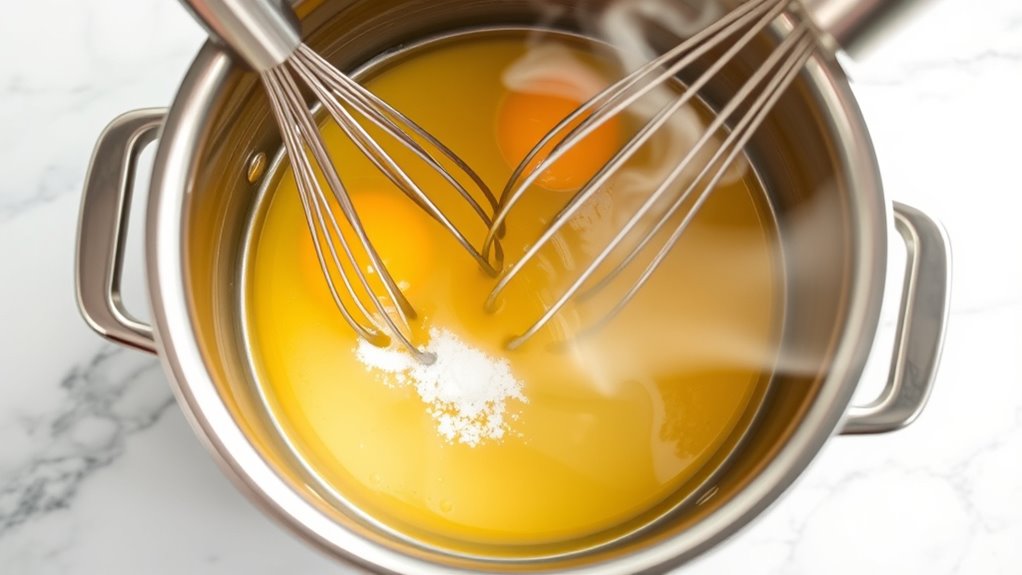To pasteurize eggs without cooking them for tiramisu, gently heat them over a double boiler until reaching about 160°F (71°C) while stirring constantly. Use a thermometer to monitor the temperature closely to prevent cooking. Once the eggs hit the target temperature, quickly cool them to preserve their silky texture. Proper pasteurization guarantees safety against Salmonella. Keep going to discover more tips for making your tiramisu both safe and delicious.
Key Takeaways
- Gently heat eggs over a double boiler to 160°F (71°C), monitoring with a thermometer to ensure safety without cooking.
- Quickly cool the eggs after reaching the target temperature to prevent coagulation and maintain a raw-like texture.
- Use a precise, indirect heat method to pasteurize eggs evenly and safely for tiramisu preparation.
- Alternatively, opt for commercially pasteurized eggs to eliminate the need for heating during the recipe.
- Follow strict temperature control and timing guidelines to effectively pasteurize eggs without cooking them.

Have you ever wondered what makes Italian tiramisu a beloved dessert worldwide? The answer lies in its delicate balance of flavors, creamy texture, and the art of safe preparation. One of the key ingredients in traditional tiramisu is raw eggs, which give it that rich, silky consistency. However, egg safety is a common concern, especially since raw eggs can carry Salmonella. To address this, many home cooks and chefs have devised methods to pasteurize eggs without cooking them, ensuring the dessert remains safe to enjoy. This process involves gently heating the eggs to a temperature that kills harmful bacteria but doesn’t cook the eggs, preserving their raw-like quality. By doing so, you can confidently incorporate raw eggs into your tiramisu, providing that authentic texture without risking foodborne illness.
There are several ways to pasteurize eggs for tiramisu safely. One popular method involves heating eggs gently over a double boiler until they reach about 160°F (71°C), then quickly cooling them down. This technique requires a thermometer to monitor the temperature carefully, so you don’t inadvertently cook the eggs. Alternatively, you can purchase pasteurized eggs, which are commercially processed to eliminate bacteria without heat. Using pasteurized eggs offers peace of mind, especially if you’re preparing the dessert for children, pregnant women, or anyone with a compromised immune system. Once you’ve pasteurized your eggs, you can proceed with whipping them into a luscious mascarpone mixture, confident that your dessert is both delicious and safe.
Additionally, understanding the science of pasteurization helps ensure you follow the proper safety guidelines and avoid foodborne illnesses. The versatility of tiramisu extends beyond the traditional recipe, offering plenty of dessert variations to suit different tastes and dietary needs. For example, you can replace traditional ladyfingers with gluten-free or vegan alternatives, or incorporate fruit flavors like strawberries or raspberries for a fresh twist. Some recipes experiment with flavored liqueurs, such as coffee liqueur or amaretto, to add depth. You can also make a lighter version by swapping mascarpone for Greek yogurt or using less sugar. Proper egg handling is essential in all variations to maintain safety and quality. Pasteurizing eggs allows you to explore these creative options without compromising safety, making your tiramisu both innovative and trustworthy.
Furthermore, employing proper storage techniques for your eggs and dessert components helps maintain freshness and safety throughout the preparation process. In the end, understanding egg safety and exploring dessert variations empower you to craft a perfect tiramisu tailored to your preferences. By pasteurizing your eggs properly, you preserve the authentic creaminess that makes tiramisu so irresistible, all while ensuring it’s safe to serve. Whether sticking to the classic recipe or experimenting with new flavors, your attention to egg safety and ingredient quality elevates your dessert from good to extraordinary.
Frequently Asked Questions
Can I Use Raw Eggs in Homemade Tiramisu Safely?
You might wonder if you can use raw eggs in your homemade tiramisu safely. To guarantee egg safety, you can use a pasteurization process that gently heats eggs to kill harmful bacteria without cooking them. This method allows you to enjoy traditional tiramisu with raw eggs, reducing health risks. Always opt for pasteurized eggs or carefully follow a pasteurization technique to keep your dessert safe and delicious.
What Are the Best Egg Substitutes for Tiramisu?
If you’re looking for egg substitutes in tiramisu, consider egg-free alternatives like mascarpone, cream cheese, or silken tofu. These options provide a creamy texture without raw eggs. To guarantee safety, use pasteurization techniques such as heating your ingredient mixture gently or buying pre-pasteurized products. This way, you enjoy a delicious, safe tiramisu without risking raw egg consumption, perfect for those with dietary restrictions or allergies.
How Long Does Pasteurizing Eggs Take?
The pasteurization process for eggs typically takes about 3 to 5 minutes at a temperature of 140°F (60°C). This duration guarantees egg safety by effectively reducing harmful bacteria without cooking the eggs. You need to monitor the temperature carefully, using a thermometer, to prevent overcooking. During this process, your goal is to safely pasteurize eggs while maintaining their raw-like texture, perfect for recipes like tiramisu.
Is There a Difference in Taste Between Pasteurized and Raw Eggs?
You might wonder if pasteurized eggs taste different from raw eggs. Generally, there’s little to no change in egg flavor, but some people notice subtle texture differences, like slightly less runny yolks. Pasteurization helps guarantee safety without compromising taste or texture considerably. So, if you prefer a safer option, you can enjoy your dishes with confidence, knowing the egg’s flavor remains mostly intact, with minimal texture changes.
Can I Make Tiramisu Without Eggs Altogether?
You can definitely make tiramisu without eggs by exploring eggless alternatives or dairy-free options. Instead of raw eggs, try using aquafaba (the liquid from chickpeas) or silken tofu to mimic the texture and richness. These substitutions guarantee you avoid raw eggs while still achieving that creamy, luscious quality. Plus, they cater to dietary restrictions, making your tiramisu accessible and delicious without compromising on flavor.
Conclusion
Now that you’ve uncovered the secret to pasteurizing eggs without cooking, you hold the key to a safer, creamier tiramisu. Imagine gently whispering health and flavor into every spoonful, turning your dessert into a silky, worry-free masterpiece. With this simple trick, you’re not just making tiramisu—you’re crafting a sweet symphony of tradition and safety, inviting everyone to indulge in a heavenly treat that’s as secure as it is divine.










